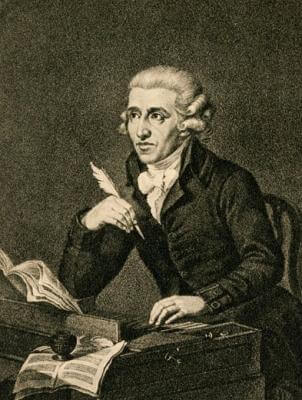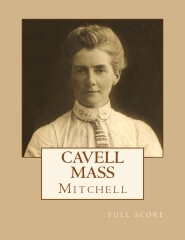The musical setting of the Latin Mass is one of the greatest monuments of western art. But it was the flower of almost two millennia of development. This is how it happened.
In the earliest centuries of the church, various biblical texts were employed in celebrating the Mass or Eucharist. Slightly later, these were joined by the Credo, which is the fourth-century Nicene Creed. From the sixth century on, six main texts began to emerge as the core liturgy of the Mass:
- Kyrie eleison (in Greek)—”Lord have mercy on us” (Matt. 20.30 and elsewhere in the psalms and gospels).
- Gloria in excelsis Deo—a hymn of praise, based on the angels’ song from Luke 2.14.
- Credo—the Nicene Creed
- Sanctus—the song of the serafim from Isaiah 6.3.
- Benedictus—an extract from Psalm 118.26, hailing the arrival of the Messiah.
- Agnus Dei—a prayer based on John 1.29.
From early times, these six texts were intoned in plainsong. (All sacred texts were chanted in ancient times.) But from the ninth century on, the single musical lines were expanded into two-part settings, either in organum, where the two parts move in parallel motion, or in diaphony, where the parts move independently. In time, more voice parts were added, until, by the early 14th century, diaphony became nascent polyphony.
In this ars nova style, medieval musicians began to write musical settings of the entire Latin mass in which a core melodic theme, or cantus firmus, quite independent of the traditional plainsong chants, gave stylistic unity to the whole. The oldest surviving such mass is Guillaume de Machaut’s Messe de Notre Dame dating from around 1350. In this way, the composers of 14th century Europe gave birth to the world’s first ever extended musical form.
In the 15th century, musical settings of the Latin mass blossomed in the hands of the Franco-Flemish polyphonic masters, Dufay, Binchois, Ockeghem, and the Englishman John Dunstable. By the 16th century, it achieved maturity in the works of Josquin, Lassus, Byrd, Tallis, Palestrina, and Victoria.

With the advent of the Reformation, the Lutheran mass was shortened to Kyrie and Gloria alone. Most of Bach’s masses are in this form. Yet his huge B Minor Mass signalled the beginning of a new trend to regard the Mass setting as a sacred musical meditation on the divine glory quite independent of the Eucharist. Later in the 18th century, the Viennese school, Haydn and Mozart, serving Catholic princes and Catholic archbishops, still set the texts of the Mass for liturgical use, but they were influenced by the structure of Haydn’s great musical invention, the symphony.
Finally, by the time of Haydn’s late masses, three separate streams converged:
- the ancient tradition of setting the Mass to music
- the growing tendency to sing the mass as a musical performance to the glory of God
- the structuring of the mass as a choral symphony in six movements
In this symphonic and performance-oriented form are all the late masses of Haydn and Mozart, and of their great Viennese successors, Beethoven and Schubert.

Looking for a modern yet traditional setting of the Latin mass? Check out my Cavell Mass. You can get the music from Amazon.
Text for musical settings of the Latin Mass
Greek and Latin text followed by English translation
Kyrie eleison. Christe eleison. Kyrie eleison.
Lord, have mercy. Christ, have mercy. Lord, have mercy.
Gloria in excelsis Deo et in terra pax homínibus bonae voluntatis. Laudamus te, benedícimus te, adoramus te, glorificamus te, gratias agimus tibi propter magnam gloriam tuam, Domine Deus, Rex cælestis, Deus Pater omnípotens. Domine Fili unigenite, Iesu Christe, Domine Deus, Agnus Dei, Fílius Patris : qui tollis peccata mundi, miserere nobis; qui tollis peccata mundi, suscipe deprecationem nostram; qui sedes ad dexteram Patris, miserere nobis. Quoniam tu solus Sanctus, tu solus Dominus, tu solus altíssimus, Iesu Christe, cum Sancto Spíritu : in gloria Dei Patris. Amen.
Glory to God in the highest. And on earth peace to men of good will. We praise you; we bless you; we worship you; we glorify you. We give you thanks for your great glory, Lord God, Heavenly King, God the Father Almighty. Lord, Son only-begotten, Jesus Christ, Lord God, Lamb of God, Son of the Father: you take away the sins of the world, have mercy on us; you take away the sins of the world, receive our prayer; you sit at the right hand of the Father, have mercy on us. For only you are holy, only you are Lord, only you are most high, Jesus Christ, with the Holy Spirit, in the glory of God the Father. Amen.
Credo in unum Deum, Patrem omnipotentem, factorem cæli et terræ, visibílium omnium et invisibílium. Et in unum Dominum Iesum Christum, fílium Dei unigenitum, et ex Patre natum ante omnia sæcula. Deum de Deo, lumen de lumine, Deum verum de Deo vero, genitum, non factum, consubstantialem Patri : per quem omnia facta sunt. Qui propter nos homines et propter nostram salutem descendit de cælis. Et incarnatus est de Spíritu Sancto ex María Vírgine, et homo factus est. Crucifíxus etiam pro nobis sub Pontio Pilato; passus, et sepultus est. Et resurrexit tertia die, secundum Scripturas, et ascendit in cælum, sedet ad dexteram Patris. Et íterum venturus est cum gloria iudicare vivos et mortuos, cuius regni non erit finis. Et in Spíritum Sanctum, Dominum et vivificantem : qui ex Patre Filioque procedit : qui cum Patre et Fílio simul adoratur et conglorificatur : qui locutus est per prophetas. Et unam, sanctam, catholicam et apostolicam Ecclesiam. Confíteor unum baptísma in remissionem peccatorum. Et expecto resurrectionem mortuorum, et vitam venturi sæculi. Amen.
I Believe in one God; the Father almighty, maker of heaven and earth, and of all things visible and invisible. And in one Lord Jesus Christ, the only-begotten Son of God, begotten of the Father before all worlds; God of God, light of light, true God of true God, begotten not made; being of one substance with the Father, by whom all things were made. Who for us men and for our salvation descended from heaven; And was incarnate by the Holy Spirit of the Virgin Mary, and was made man. He was crucified for us under Pontius Pilate; he died and was buried. He rose again the third day, according to the Scriptures: and ascended into heaven. He sits at the right hand of the Father; and he shall come again with glory to judge the living and the dead; and his reign will have no end. I believe in the Holy Spirit, the Lord, the giver of life, who proceeds from the Father and the Son, who with the Father and the Son is alike worshipped and glorified; who was foretold by the Prophets. I believe in one holy catholic and apostolic Church. I acknowledge one baptism for the remission of sins. And I await the resurrection of the dead and the life of the world to come. Amen.
Sanctus, sanctus, sanctus, Domine Deus Sabaoth. Pleni sunt cæli et terrae gloria tua. Osanna in excelsis.
Holy, Holy, Holy, Lord God of Hosts. Heaven and earth are full of your glory. Hosanna in the highest.
Benedictus qui venit in nomine Domine. Osanna in excelsis.
Blessed is he who comes in the name of the Lord. Hosanna in the highest.
Agnus Dei qui tollis peccata mundi, miserere nobis.
Agnus Dei qui tollis peccata mundi, miserere nobis.
Agnus Dei qui tollis peccata mundi, dona nobis pacem.
Lamb of God, who takes away the sins of the world, have mercy on us.
Lamb of God, who takes away the sins of the world, have mercy on us.
Lamb of God, who takes away the sins of the world, grant us peace.
